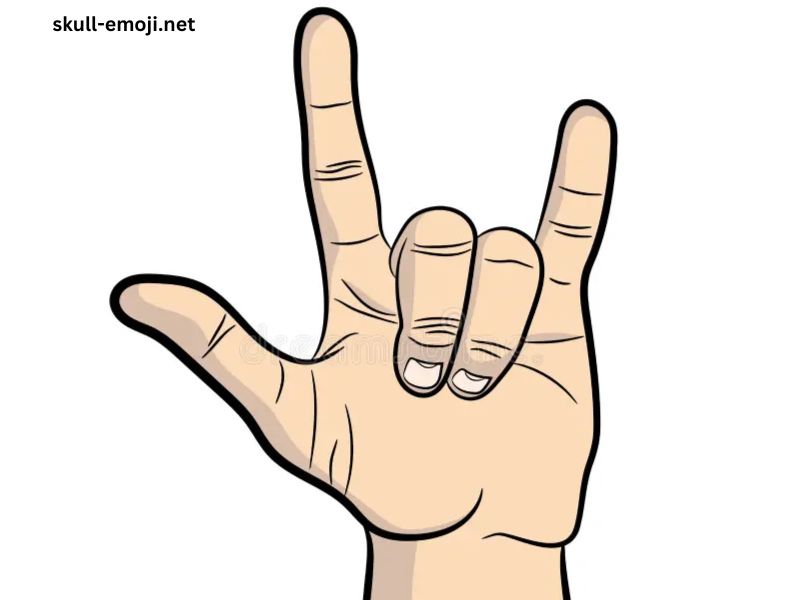The “rock and roll hand sign,” often referred to as the “horns,” is one of the most recognizable gestures in music culture. Frequently associated with rock and roll, heavy metal, and countercultural movements, this iconic hand gesture—made by extending the index and little fingers while holding down the middle and ring fingers, typically accompanied by a raised fist—has become a symbol of defiance, rebellion, and unity among music fans. However, the history and meaning of the sign go far beyond its association with rock music. In this article, we’ll explore the origins of the rock and roll hand sign, its cultural and historical context, and its evolution in modern music and society.
Origins of the Rock and Roll Hand Sign
The rock and roll hand sign, commonly known as the “sign of the horns” (or “corna” in Italian), has roots in both ancient and modern traditions. While it is most closely linked to rock and roll music, its origins can be traced to various cultural symbols and gestures that predate the genre.
1. Ancient and Cultural Roots
The gesture of extending the index and little fingers while holding down the middle and ring fingers is a shape that has appeared in various cultures throughout history. One of the earliest references to the gesture comes from Italy, where it was used as a symbol of “malocchio” or the “evil eye.” The “corna” was believed to ward off bad luck, negative energy, or curses. Italians would use the sign to protect themselves from the envy or jealousy of others, as it was thought to divert the power of the evil eye and bring good fortune.
The “corna” gesture was not limited to Italy. Similar signs appear in ancient Mediterranean cultures. In Greek mythology, for example, the “horned” symbol was used to represent the idea of strength and power. The “horned” gesture was also used in Hinduism and Buddhism as a symbol of protection or to invoke spiritual forces.
In the context of Western pop culture, the rock and roll hand sign, or the “sign of the horns,” was also utilized by figures like the ancient Roman emperor Augustus. His right hand was frequently depicted in a gesture resembling the modern-day rock and roll sign, which likely served both as a symbol of power and a protective charm.
2. The Gesture in Music Culture
While the cultural and ancient origins of the “horns” gesture are vast, its popularization in the 20th century is largely attributed to music, specifically the world of rock and roll. The gesture gained prominence in the 1960s and 1970s, thanks to a handful of influential musicians who adopted and transformed its meaning.
One of the earliest figures to introduce the hand sign into the rock and roll lexicon was the legendary guitarist Jimmy Page of Led Zeppelin. Page began using the gesture in the 1960s as a way of expressing his identity and musical philosophy. Page often wore the “sign of the horns” during performances, emphasizing a sense of mystery and rebellion that became a hallmark of the band’s persona.
However, the true popularization of the gesture in rock culture is often attributed to Ronnie James Dio, the iconic heavy metal singer best known for his work with Rainbow, Black Sabbath, and his solo career. Dio, who joined Black Sabbath in 1979, was responsible for incorporating the “horns” sign into heavy metal music culture. According to Dio, he learned the gesture from his Italian grandmother, who used it to ward off the “evil eye.” He began using it during concerts as a form of audience engagement and to evoke a sense of solidarity with fans.
Dio’s embrace of the sign was not only a nod to Italian superstition but also a gesture that fit perfectly with the rebellious, anti-authoritarian ethos of the emerging heavy metal genre. His use of the “horns” sign helped to define the visual language of metal music, and it quickly became associated with a sense of freedom, power, and defiance against societal norms.
Symbolism of the Rock and Roll Hand Sign
Over time, the rock and roll hand sign evolved from its superstitious roots into a broader symbol within music and popular culture. Today, it is widely recognized as a symbol of rock and roll rebellion, freedom, and unity. But what does the “sign of the horns” really represent? Its meaning is multifaceted, as it embodies different symbolic layers depending on the context in which it is used.
1. Rebellion and Defiance
The rock and roll hand sign is perhaps best known for its association with rebellion. In its early days, rock and roll music was a reaction against the more conservative and staid cultural norms of the time. The “horns” gesture became a way for fans and musicians alike to express their defiance against authority, conformity, and societal expectations. In this sense, the gesture embodies the ethos of rock music itself—a genre defined by its rejection of the status quo and its embrace of individualism and nonconformity.
For many, making the sign is an affirmation of freedom and independence. Whether it’s a young person at a concert waving their hand in the air or a rock star giving a salute to their fans, the gesture is a form of solidarity with the outsider, the underdog, and the countercultural movement.
2. Unity and Brotherhood
Though it carries a rebellious connotation, the rock and roll hand sign also symbolizes unity and camaraderie among fans. At concerts, especially in the realms of heavy metal and hard rock, fans use the hand gesture as a way to communicate with each other, signaling that they share a common bond through music. It’s a symbol of solidarity, a way to show that they belong to the same tribe, a community that transcends differences in age, race, or background.
This sense of unity is especially important in the metal community, where fans often feel marginalized or misunderstood by mainstream society. The rock and roll hand sign becomes a way of finding like-minded individuals who share a passion for the music and the lifestyle associated with it.
3. Power and Strength
The “horns” gesture is also closely linked to strength and power. Whether it’s used by a musician on stage or by a fan in the audience, the hand sign conveys an aura of strength and confidence. It evokes the image of a bull or another powerful animal, symbolizing dominance, ferocity, and resilience. The horns themselves are often seen as a sign of protection, which ties back to its origins as a charm to ward off negative energy or evil.
For rock musicians, especially in the heavy metal subgenre, the sign becomes a manifestation of their onstage persona—often larger-than-life figures who use the gesture to emphasize their power and control over the audience.
Cultural Evolution and Popularization
As rock and roll and heavy metal gained popularity in the 1970s and 1980s, the “horns” sign became a fixture of live performances. Iconic figures like Ozzy Osbourne, Gene Simmons of KISS, and Lemmy Kilmister of Motörhead also adopted the gesture, further cementing its place in music culture.
In the 1990s and 2000s, the hand sign transcended music and began appearing in mainstream pop culture. From sports stadiums to social media posts, the “rock and roll horns” sign was adopted by people of all walks of life, becoming a universal symbol of energy, enthusiasm, and camaraderie. It was no longer just a gesture for rock and metal fans but had become a shorthand for the celebration of life, freedom, and empowerment.
The Rock and Roll Hand Sign in Popular Culture
The rock and roll hand sign has evolved into a global cultural symbol that extends far beyond the realm of music. Today, it is commonly seen at sporting events, in movies, on TV shows, and in advertising. Celebrities and athletes often flash the sign in public appearances, associating themselves with the energy and spirit of rock music. The gesture has also found its way into fashion, with clothing lines and merchandise bearing the sign, further cementing its place in contemporary culture.
Perhaps most notably, the rock and roll hand sign has taken on a life of its own in the age of social media. Emojis and online reactions often feature the gesture, signaling excitement, agreement, or enthusiasm. Its adoption in digital spaces further illustrates how the hand sign has transcended its musical roots and become a universal symbol of expression.
Conclusion
The rock and roll hand sign is much more than a simple hand gesture. From its ancient origins as a symbol of protection against the evil eye to its evolution into a defining symbol of rock music and counterculture, the “sign of the horns” has held deep significance across centuries and cultures. Today, it remains a powerful and enduring emblem of rebellion, unity, and empowerment, embraced by millions of music fans around the world. Whether you’re at a heavy metal concert, watching a sports game, or simply expressing excitement online, the rock and roll hand sign continues to serve as a reminder of the power of music, community, and individuality.



